Understanding Van Life and the Need for Climate Control
The Basics of Van Life
Van life enthusiasts understand the importance of a reliable cooling system, making a van life air conditioner an essential addition for comfort on the road. As you embark on your adventures, having a dependable air conditioning unit ensures you can enjoy your travels regardless of the climate. This guide explores the various types of air conditioners suitable for van life, their installation processes, maintenance tips, and the numerous benefits they offer.
Key Components of Van Life:
- Conversion: The process of transforming a standard van into a livable space includes installing essential amenities like a bed, kitchen, and storage solutions. This can range from DIY projects to professional conversions, depending on the owner’s budget and skills.
- Community: Van life fosters a sense of community among like-minded individuals. Many van lifers share tips, experiences, and support through social media platforms and online forums.
- Adventure: Living in a van allows individuals to experience nature, visit new places, and enjoy a lifestyle that promotes adventure and exploration.

Why a Comfortable Climate is Essential for Van Life
A comfortable climate is crucial for enhancing the overall experience of van life. The ability to regulate temperature and maintain a pleasant living environment can significantly impact health, comfort, and enjoyment during travels.
-
Health Benefits: Extreme temperatures can lead to discomfort and health issues, such as heat exhaustion or respiratory problems due to poor air quality. An effective air conditioning system helps maintain a comfortable temperature, promoting better health.
-
Improved Sleep Quality: Adequate temperature control is vital for a good night’s sleep. A van that is too hot or too cold can make it challenging to rest, impacting energy levels and overall well-being. An air conditioner can provide a cool, comfortable sleeping environment, allowing for restful nights on the road.
-
Enhanced Lifestyle: A comfortable climate allows van lifers to enjoy their surroundings fully. Whether parked by the beach, in the mountains, or at a campsite, having climate control means you can enjoy these locations without being hindered by uncomfortable weather conditions.
-
Flexibility and Convenience: Having a reliable air conditioning system means that van lifers can venture into warmer climates without the fear of overheating. It also allows for extended stays in locations that may not have adequate natural ventilation or shade.

Conclusion
Understanding the essentials of van life and the importance of climate control is fundamental for anyone considering this lifestyle. With the right air conditioning system, van lifers can enjoy their adventures while staying comfortable and healthy, allowing them to focus on the journey rather than the elements.

Types of Air Conditioners for Van Life
When it comes to staying cool in your van, choosing the right type of air conditioner is essential. Each option has its pros and cons, depending on your specific needs, budget, and available space. Below are the most popular types of air conditioners for van life, designed to help you make an informed decision.
Rooftop Air Conditioners
Rooftop air conditioners (RV air conditioners) are a popular choice among van lifers for their effectiveness and efficient cooling. These units are mounted on the roof of the vehicle, allowing them to maximize space inside the van while delivering powerful cooling capabilities.
Advantages:
- Space-Saving Design: Since rooftop units are installed on the roof, they don’t take up valuable interior space, leaving more room for living and storage.
- High Cooling Capacity: Rooftop AC units typically have a higher BTU (British Thermal Unit) rating, making them suitable for cooling larger spaces.
- Energy Efficiency: Many modern rooftop units are designed to be energy-efficient, which is essential for off-grid van lifers relying on solar power or battery systems.
Considerations:
- Installation Complexity: Installing a rooftop air conditioner may require cutting into the van’s roof, which can be daunting for DIYers.
- Cost: Rooftop units tend to be more expensive than portable alternatives, both in terms of the unit itself and installation.

Portable Air Conditioners
Portable air conditioners offer flexibility and convenience for van lifers who may need cooling in various settings. These units can be moved from one location to another, providing a versatile solution for hot weather.
Advantages:
- Easy Setup: Portable units typically require minimal installation and can be set up quickly, making them ideal for temporary cooling solutions.
- Versatility: These units can be used both in the van and outside, allowing for cooling wherever needed, such as at campsites or during outdoor activities.
- Cost-Effective: Portable air conditioners tend to be more affordable than rooftop models, making them an accessible option for many van lifers.
Considerations:
- Cooling Capacity: While convenient, portable units generally have lower BTU ratings, making them less effective for larger spaces.
- Space Requirements: They take up floor space inside the van, which may be a concern for those with limited room.
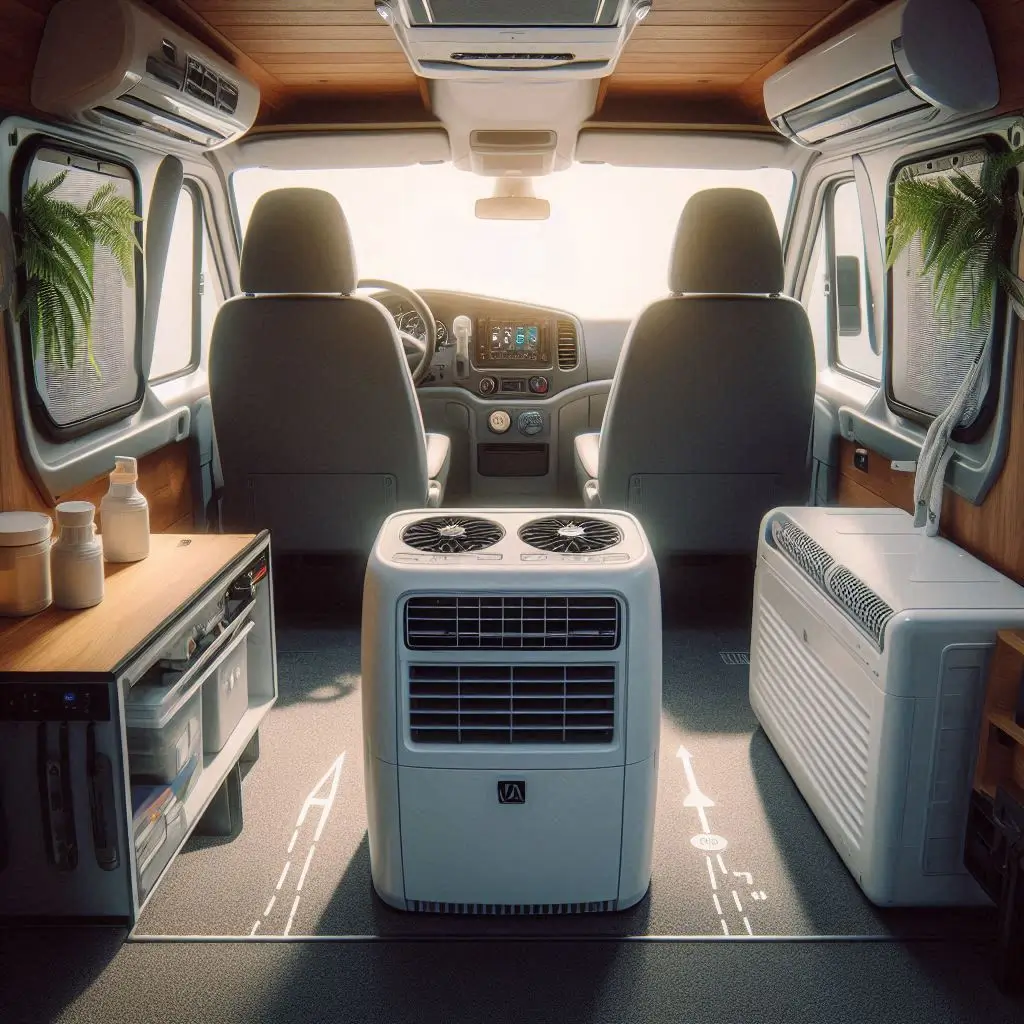
Ductless Mini-Split Systems
Ductless mini-split systems are becoming increasingly popular for van life due to their efficiency and quiet operation. These systems consist of an outdoor compressor and an indoor air handler, providing powerful cooling without ductwork.
Advantages:
- Energy Efficiency: Mini-split systems are highly efficient and can significantly reduce energy consumption compared to traditional AC units.
- Quiet Operation: These systems operate more quietly than many other types of air conditioners, ensuring a peaceful environment inside the van.
- Zoned Cooling: Ductless systems allow for customizable temperature control in different areas of the van, providing personalized comfort.
Considerations:
- Installation Complexity: Like rooftop units, mini-splits require professional installation and may involve more complex setup procedures.
- Cost: They are generally more expensive than both rooftop and portable units, which may be a limiting factor for some van lifers.
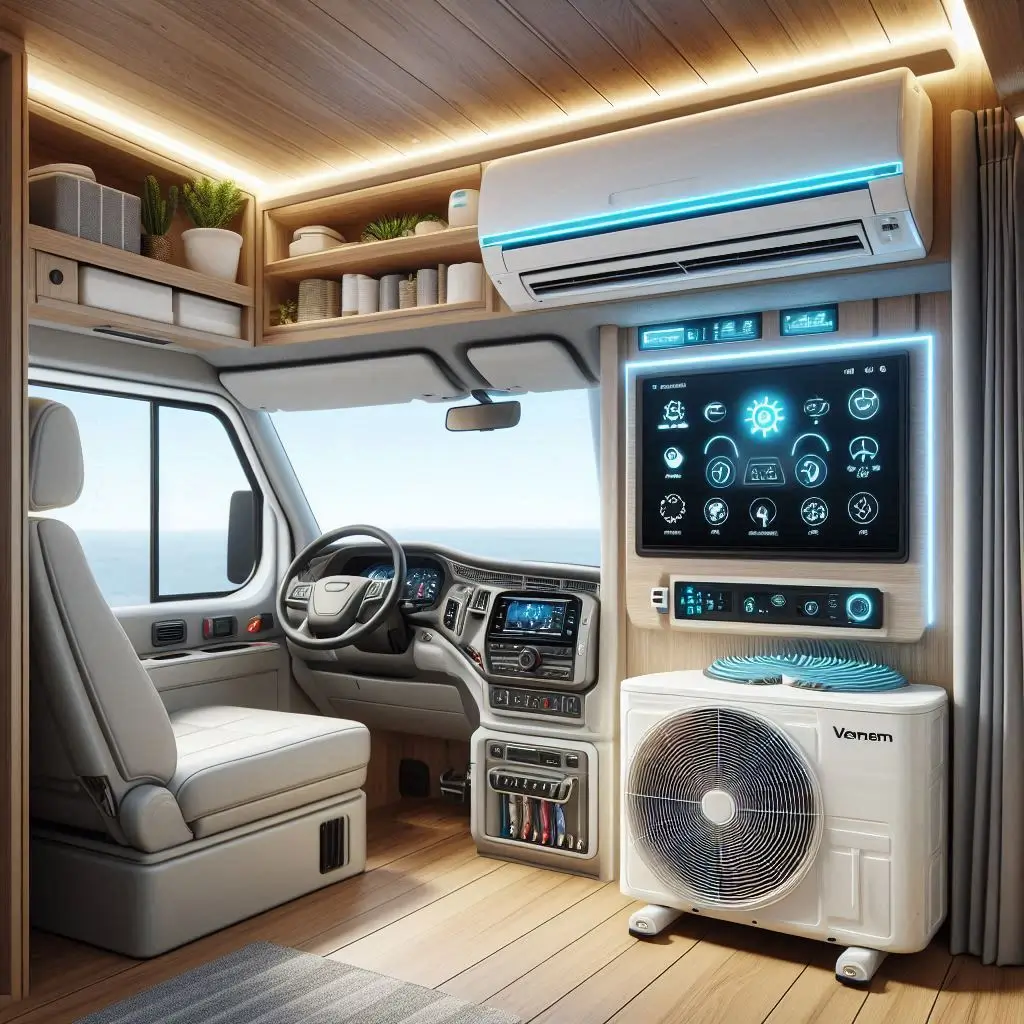
Conclusion
Choosing the right air conditioner for your van life setup is crucial for comfort and convenience. Rooftop air conditioners, portable units, and ductless mini-split systems each have unique advantages and considerations. By understanding these options, you can make an informed decision that best fits your lifestyle and needs.
Choosing the Right Van Life Air Conditioner
Selecting the appropriate air conditioner for your van life setup is crucial for comfort, energy efficiency, and overall satisfaction. With various options available, understanding the key factors to consider can help you make an informed decision tailored to your specific needs.
Factors to Consider When Selecting an AC Unit
When choosing an air conditioner for your van, several factors play a significant role in determining the best fit for your lifestyle and preferences:
-
Space Constraints: Consider the size and layout of your van. Limited space may require a compact or portable unit, while larger vans might accommodate a rooftop or ductless mini-split system.
-
Climate and Usage: Assess the typical climate conditions you will encounter during your travels. If you often travel to hot areas, a more powerful unit with a higher BTU rating may be necessary. Conversely, if you plan to camp in cooler regions, a smaller, more energy-efficient model could suffice.
-
Budget: Air conditioner prices can vary widely based on type, brand, and features. Set a budget before shopping and factor in installation costs if you choose a rooftop or mini-split system.
-
Installation Complexity: Evaluate your skills and comfort level with installation. Rooftop and ductless systems often require more extensive installation, while portable units typically just need to be plugged in.
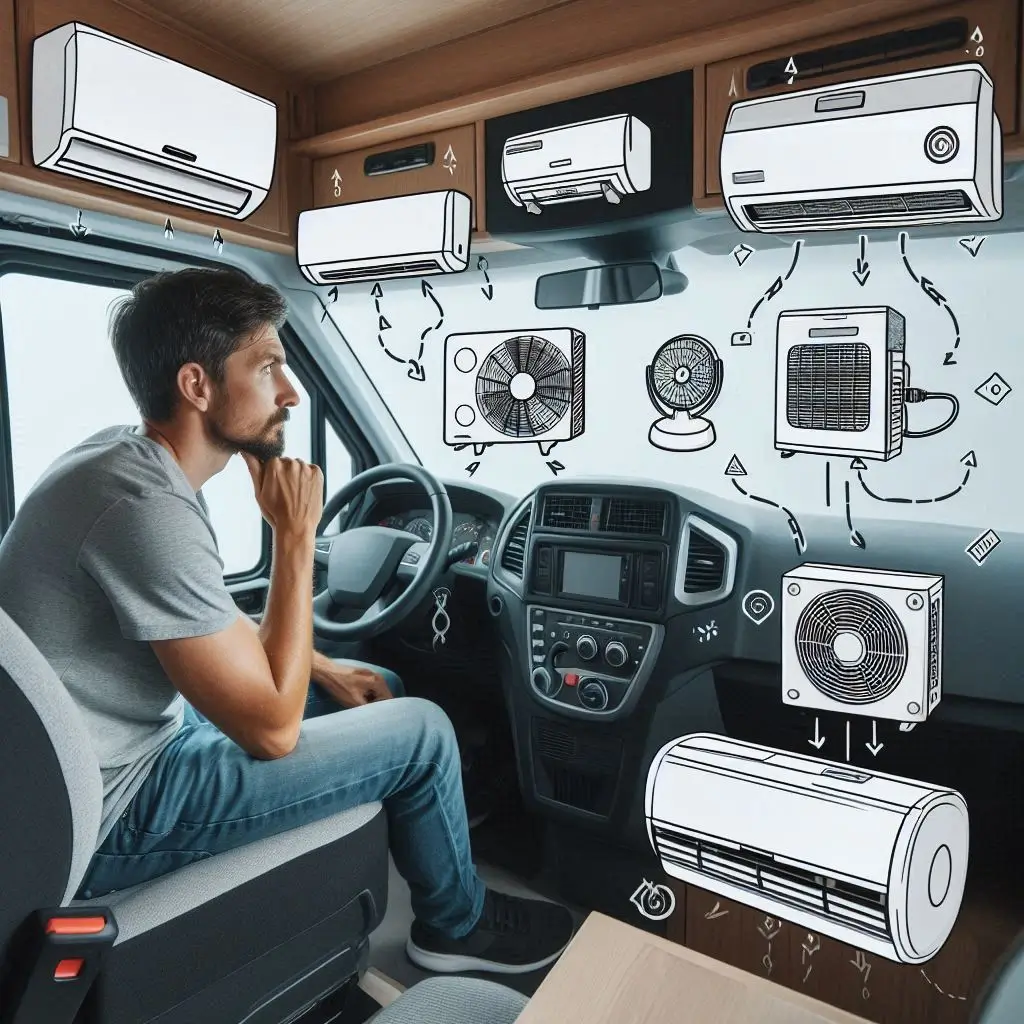
Size and Capacity Requirements
The size and capacity of the air conditioner you choose are critical for efficient cooling. BTU (British Thermal Units) is the standard measurement used to determine an air conditioner’s cooling capacity.
-
Calculating BTU Needs: To ensure optimal performance, consider the following factors when calculating the necessary BTU:
- Van Size: Measure the interior square footage of your van. A general rule of thumb is to allow 20 BTUs per square foot. For example, if your van is 100 square feet, you would need an air conditioner with a capacity of around 2,000 BTUs.
- Insulation Quality: If your van is well-insulated, you may require a lower BTU capacity. Conversely, if the insulation is poor, you might need a higher capacity to compensate for heat loss or gain.
- Occupancy: Consider the number of people who will typically be in the van. More occupants generate additional heat, increasing your BTU requirements.
-
Balancing Size and Power: Choosing an air conditioner that is too small will lead to insufficient cooling, while one that is too large can result in inefficient energy use and increased wear on the unit. Strive for a balanced approach to ensure comfort and efficiency.

Energy Efficiency Ratings
Energy efficiency is a critical consideration for van lifers, especially those relying on solar power or limited battery capacity. Understanding energy efficiency ratings can help you select a unit that minimizes energy consumption without sacrificing performance.
-
EER and SEER Ratings: Look for air conditioners with high Energy Efficiency Ratio (EER) and Seasonal Energy Efficiency Ratio (SEER) ratings. These ratings indicate how efficiently the unit uses electricity to provide cooling:
- EER measures the cooling output (in BTUs) per watt of electricity consumed, typically at high temperatures.
- SEER measures the efficiency over a typical cooling season, factoring in varying temperatures.
-
Energy Star Certification: Consider air conditioners with Energy Star certification. These units meet stringent energy efficiency guidelines set by the Environmental Protection Agency (EPA) and can significantly reduce your energy costs.
-
Inverter Technology: Units with inverter technology can provide variable speed cooling, allowing the compressor to adjust its speed based on the cooling needs. This feature enhances efficiency and reduces energy consumption, making it an excellent choice for off-grid living.
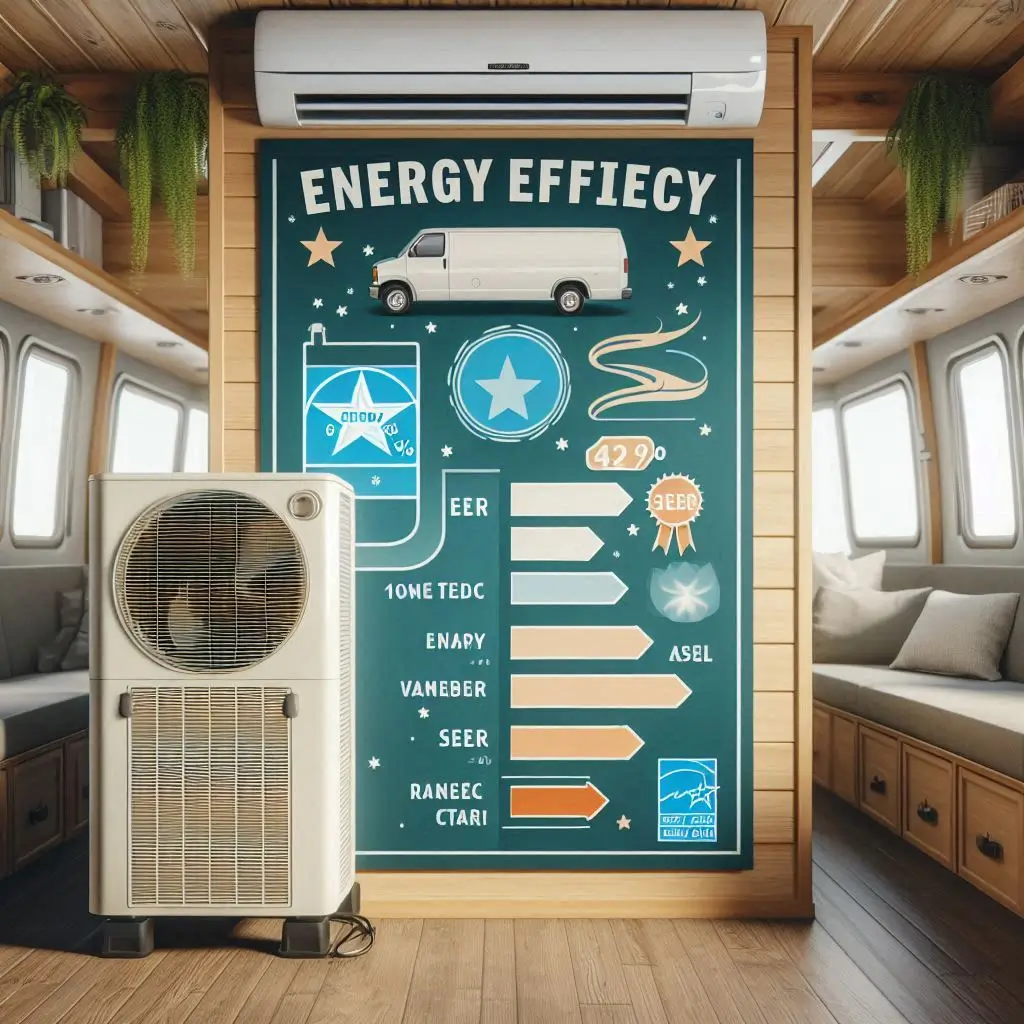
Conclusion
Choosing the right van life air conditioner involves careful consideration of various factors, including space constraints, size and capacity requirements, and energy efficiency ratings. By understanding these elements, you can select an air conditioning unit that meets your needs, ensuring a comfortable and enjoyable van life experience.
Installation Guide for Van Life Air Conditioners
Installing an air conditioner in your van is an essential step to ensure comfort during your travels. Whether you choose a rooftop, portable, or ductless mini-split system, following a systematic approach to installation will help you achieve optimal performance. This guide will cover preparation, the step-by-step installation process, and considerations for professional versus DIY installation.
Preparing Your Van for AC Installation
Proper preparation is crucial before starting the installation of your air conditioning unit. Follow these steps to ensure a smooth installation process:
-
Choose the Right Location:
- For rooftop air conditioners, select a flat section of the roof, away from vents and obstructions. Ensure that the roof can support the weight of the unit and that there’s adequate clearance for installation.
- For portable units, identify a space with easy access to power outlets and good airflow.
-
Gather Necessary Tools and Materials:
- Collect tools such as a drill, screwdriver, level, sealant, and any mounting hardware provided with the AC unit. For portable units, ensure you have extension cords if needed.
- Review the manufacturer’s installation manual for any additional tools or materials specific to the unit.
-
Ensure Electrical Readiness:
- Check your van’s electrical system to ensure it can handle the additional load from the air conditioning unit. If necessary, upgrade your battery or solar system to accommodate the energy demands of the AC.
- Consider installing a dedicated circuit to prevent overloading your existing electrical system.
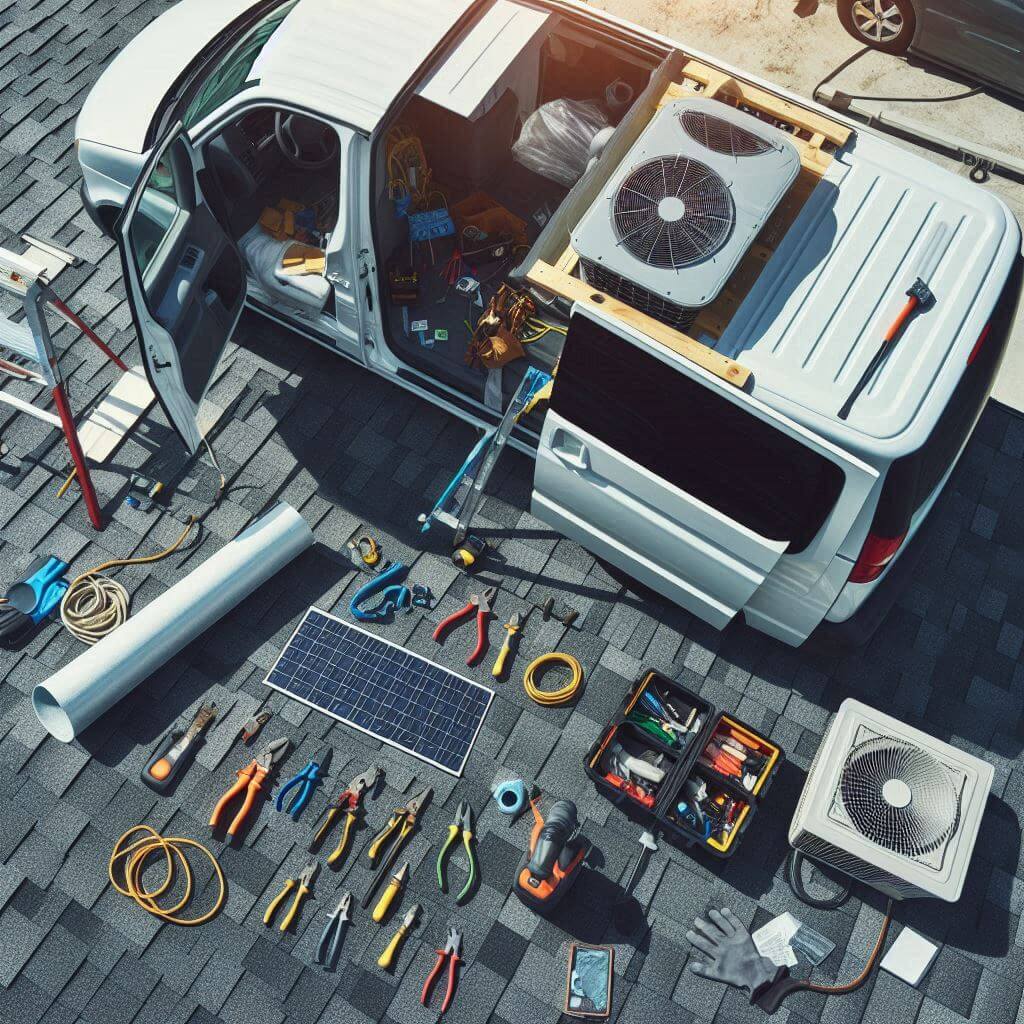
Step-by-Step Installation Process
Once you’ve prepared your van, follow these steps for a successful air conditioner installation:
-
Rooftop Air Conditioner Installation:
- Cutting the Roof: If installing a rooftop unit, carefully measure and cut an opening in the van’s roof according to the manufacturer’s guidelines. Use a jigsaw or reciprocating saw to ensure a clean cut.
- Seal the Edges: Apply sealant around the cut edges to prevent water leaks and rust formation.
- Position the Unit: Carefully lift the AC unit onto the roof, aligning it with the cutout. Use a helper if necessary, as rooftop units can be heavy.
- Secure the Unit: Follow the manufacturer’s instructions to secure the unit in place, typically using bolts and brackets. Ensure it is level to promote proper drainage.
- Connect Electrical Wiring: Run the electrical wiring through the roof into the van, connecting it to your power system. Double-check the connections to avoid any short circuits.
-
Portable Air Conditioner Installation:
- Set Up the Unit: Place the portable AC in the desired location inside the van. Ensure it has enough space for airflow and access to an electrical outlet.
- Ventilation: Install the exhaust hose according to the manufacturer’s instructions. Typically, this involves attaching it to a window or vent to expel hot air outside.
- Power Up: Plug the unit into the electrical outlet and test its functionality.
-
Ductless Mini-Split System Installation:
- Mount the Indoor Unit: Choose a suitable location on the interior wall for the air handler. Use a level to ensure proper installation.
- Install the Outdoor Unit: Position the compressor outside, ensuring adequate airflow. Follow the manufacturer’s guidelines for securing it.
- Connect Refrigerant Lines: Run the refrigerant lines and electrical wiring between the indoor and outdoor units, ensuring they are properly insulated and secured.
- Test the System: Once all connections are made, turn on the unit and check for proper operation, including cooling performance and any potential leaks.
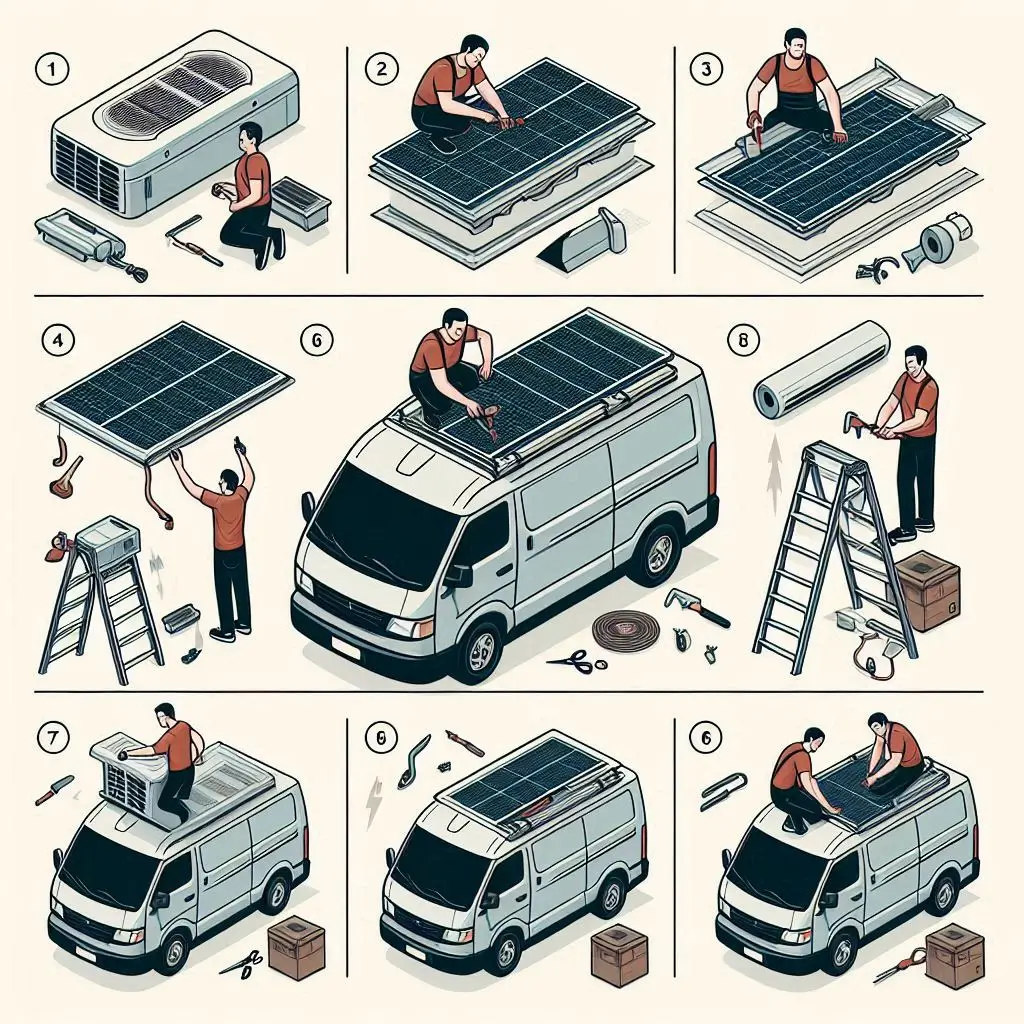
Professional vs. DIY Installation
Deciding between professional installation and a DIY approach depends on your skills, comfort level, and budget. Here are some considerations for each option:
-
DIY Installation:
- Cost Savings: Installing the air conditioner yourself can save money on labor costs. However, ensure you have the necessary tools and skills to avoid costly mistakes.
- Flexibility: DIY installation allows you to work at your own pace and customize the setup according to your preferences.
- Learning Experience: Completing the installation yourself can be a rewarding experience and provide valuable knowledge about your van’s systems.
-
Professional Installation:
- Expertise: Hiring a professional ensures that the installation is done correctly and safely. Professionals have the experience to handle challenges that may arise during installation.
- Warranty Considerations: Some manufacturers may require professional installation to maintain the warranty on the air conditioning unit.
- Time Efficiency: Professionals can typically complete the installation faster than a DIYer, allowing you to enjoy your van life sooner.
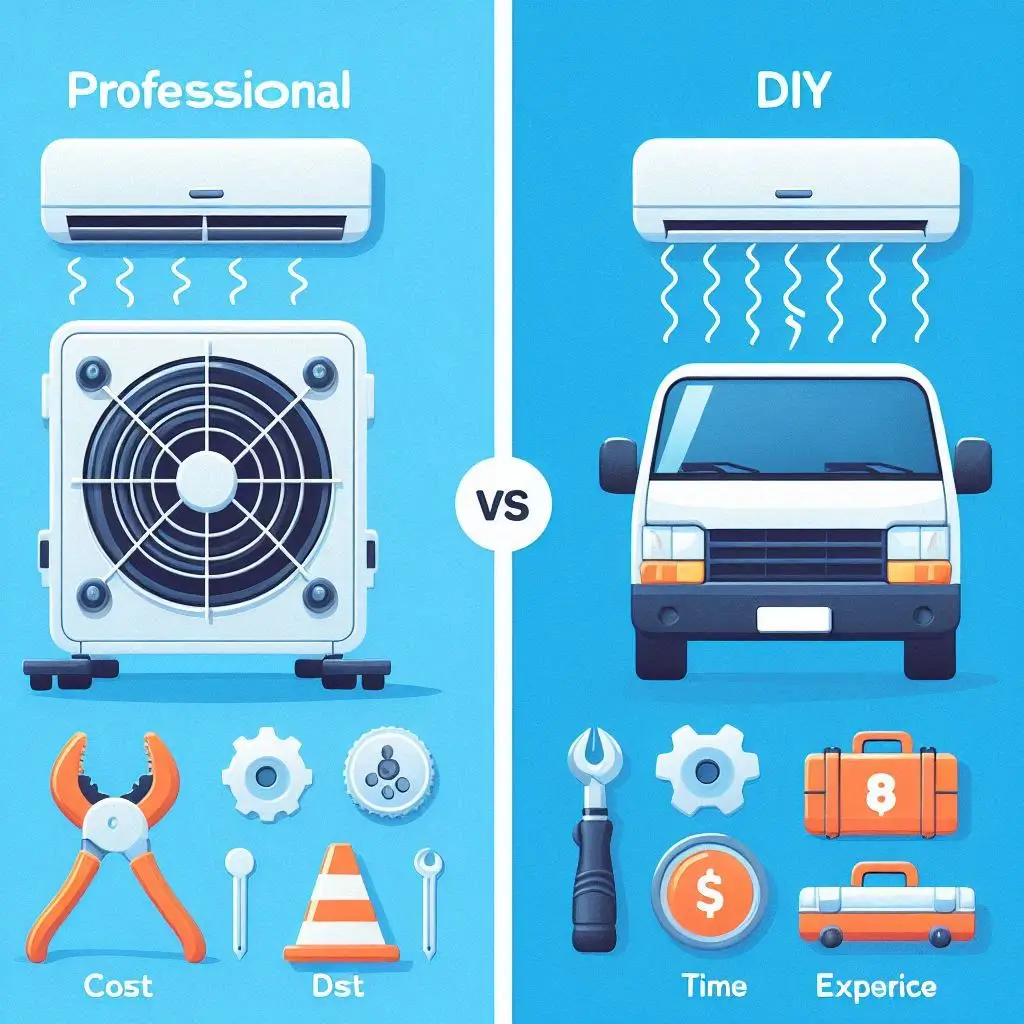
Conclusion
Installing an air conditioner in your van is a crucial step in ensuring a comfortable living environment while traveling. By preparing adequately, following a systematic installation process, and weighing the pros and cons of DIY versus professional installation, you can choose the best approach for your van life journey.
Maintenance Tips for Your Van Life Air Conditioner
Proper maintenance is essential to ensure your van life air conditioner operates efficiently and reliably throughout your travels. By following a few maintenance tips, you can enhance performance, troubleshoot common issues, and extend the lifespan of your AC unit. This guide will provide you with the necessary steps to keep your air conditioner in peak condition.
Regular Cleaning and Maintenance
Regular cleaning and maintenance are vital for optimal performance and efficiency of your van life air conditioner. Implement the following practices to keep your unit running smoothly:
-
Clean or Replace Air Filters:
- Air filters trap dust, debris, and allergens, ensuring clean air circulation. Check your air filters monthly and clean them if washable or replace them if disposable.
- Clogged filters can restrict airflow, reducing efficiency and causing the system to work harder, leading to increased energy consumption.
-
Inspect the Coils:
- Both the evaporator and condenser coils should be inspected for dirt and debris accumulation. Clean them as needed using a soft brush or a vacuum with a brush attachment.
- Dirty coils can significantly decrease cooling efficiency and lead to potential system failures.
-
Clear Drain Lines:
- Regularly check and clear the condensate drain lines to prevent clogs and ensure proper drainage. Use a wet/dry vacuum or a pipe cleaner to remove any blockages.
- Clogged drains can cause water to back up, leading to potential leaks and mold growth.
-
Inspect Insulation:
- Check the insulation on refrigerant lines for wear and damage. Replace any damaged insulation to prevent energy loss and maintain efficient cooling.
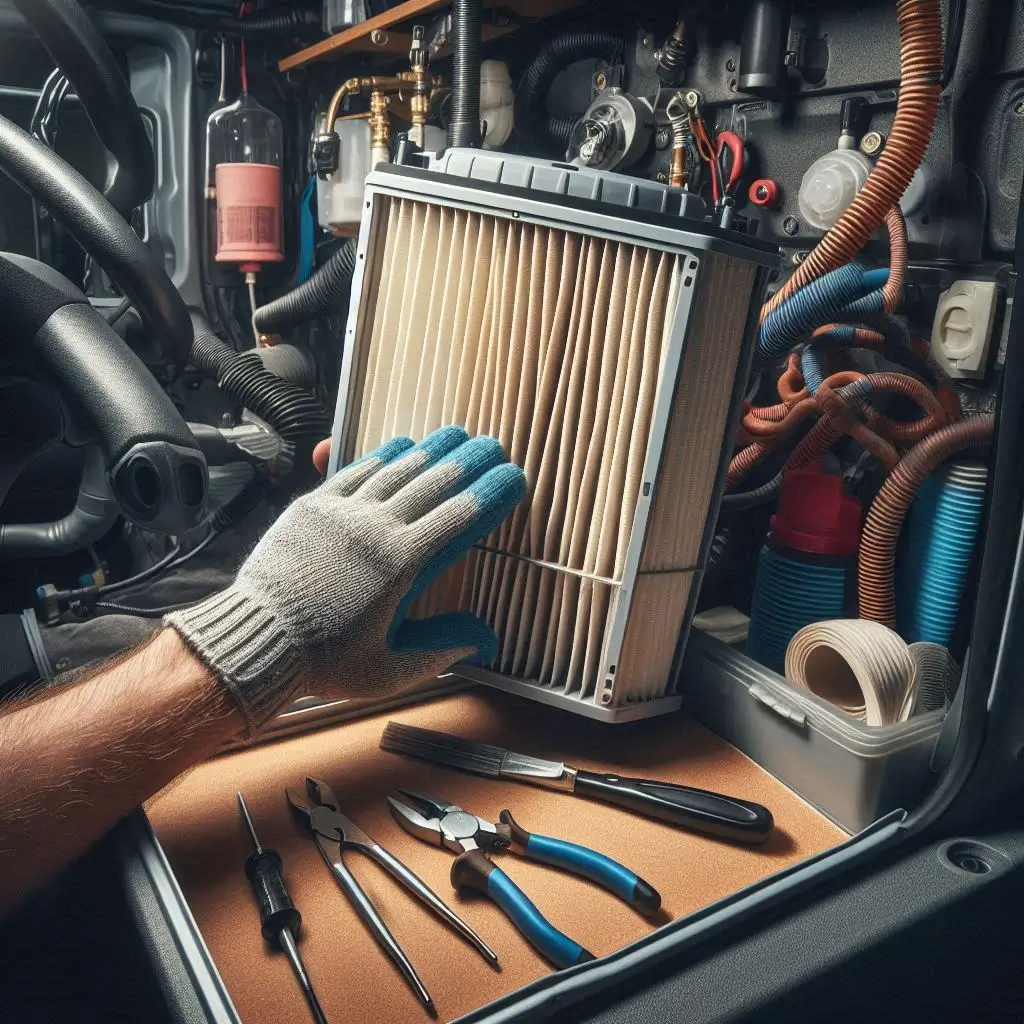
Troubleshooting Common Issues
Even with regular maintenance, issues may arise with your van life air conditioner. Here are some common problems and troubleshooting steps:
-
Air Conditioner Won’t Turn On:
- Check Power Source: Ensure that the unit is properly plugged in and that your van’s power system is functioning correctly.
- Inspect the Circuit Breaker: Check the circuit breaker for any tripped switches and reset them if necessary.
-
Insufficient Cooling:
- Clean Filters: Check and clean or replace air filters, as dirty filters can restrict airflow and reduce cooling efficiency.
- Examine Thermostat Settings: Ensure the thermostat is set to the desired temperature and functioning properly.
-
Strange Noises:
- Identify the Source: Listen for unusual sounds such as rattling, hissing, or grinding. Loose components or debris in the unit may cause these noises.
- Tighten Loose Parts: Inspect and tighten any loose screws or brackets, and remove any debris from the unit.
-
Water Leaks:
- Check Drain Pan: Inspect the drain pan for cracks or blockages. Clear any obstructions and replace the pan if damaged.
- Inspect Drain Lines: Ensure the drain lines are clear and functioning correctly to prevent water buildup.

Extending the Lifespan of Your AC Unit
To maximize the lifespan of your van life air conditioner, consider the following tips:
-
Regular Professional Inspections:
- Schedule regular inspections by a qualified HVAC technician to assess the unit’s performance and identify potential issues before they become serious problems.
- Professional maintenance can help ensure the system operates at peak efficiency.
-
Use the Unit Wisely:
- Avoid setting the thermostat to excessively low temperatures, as this can cause the system to overwork and reduce its lifespan.
- Utilize fans or natural ventilation to assist the air conditioning system, especially during cooler temperatures.
-
Protect the Unit:
- When not in use, cover the outdoor unit to protect it from debris, snow, and ice, which can damage the components.
- Ensure the area around the unit remains clear of obstacles to promote proper airflow.
-
Monitor Performance:
- Keep an eye on the unit’s performance and be aware of any changes in efficiency or unusual sounds. Addressing issues early can prevent more significant problems down the line.

Conclusion
Maintaining your van life air conditioner is essential for ensuring its longevity and performance. By incorporating regular cleaning and maintenance, troubleshooting common issues, and following tips to extend the lifespan of your unit, you can enjoy a comfortable climate during your travels. Consistent attention to these maintenance practices will keep your air conditioner operating efficiently for years to come.
Benefits of Installing an Air Conditioner in Your Van
Installing an air conditioner in your van offers numerous benefits that enhance your overall van life experience. From improved comfort to better air quality, having an AC unit can significantly impact your enjoyment and well-being while traveling. This article explores the key advantages of having an air conditioning system in your van.
Improved Comfort and Enjoyment
One of the most significant benefits of installing an air conditioner in your van is the improved comfort it provides. Van life can often expose you to varying temperatures, making it challenging to maintain a pleasant environment. Here are some key aspects of how an AC enhances comfort:
-
Temperature Control:
- An air conditioner allows you to regulate the temperature inside your van, ensuring it remains cool during hot summer months. This capability is especially crucial when parked in sunny areas or camping sites where shade is limited.
-
Consistent Climate:
- With an AC unit, you can maintain a consistent climate, making it easier to relax and enjoy your space. This stability is particularly important for those who may be sensitive to heat or humidity.
-
Enhanced Outdoor Experiences:
- The ability to return to a cool, comfortable van after a day of outdoor activities can enhance your overall enjoyment of van life. You can unwind, recharge, and prepare for your next adventure in a pleasant environment.

Enhanced Sleep Quality
Quality sleep is essential for maintaining energy levels and overall well-being, especially when living on the road. An air conditioning unit can significantly enhance your sleep quality in several ways:
-
Cooling Down at Night:
- Hot, humid nights can make it difficult to sleep. An air conditioner can help lower the temperature in your van, creating a more comfortable sleeping environment that promotes restful sleep.
-
White Noise Effect:
- The gentle hum of an air conditioning unit can act as a soothing white noise, masking outside sounds that might disturb your sleep. This consistent background noise can help create a calming atmosphere.
-
Improved Air Circulation:
- Proper air circulation is crucial for a comfortable sleeping environment. An air conditioner helps circulate cool air, preventing stuffiness and ensuring fresh air throughout the night.
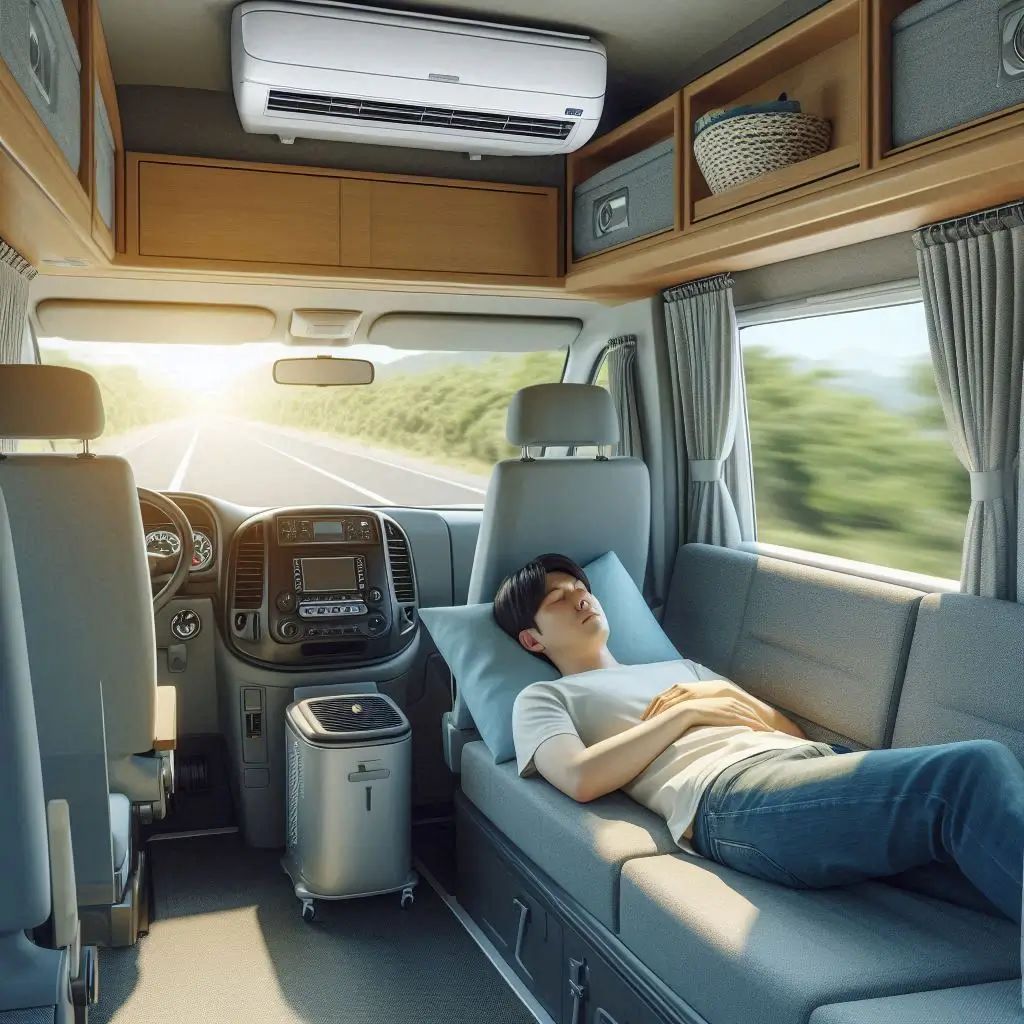
Better Ventilation and Air Quality
Installing an air conditioner in your van also contributes to better ventilation and improved air quality, which are vital for your health and comfort:
-
Humidity Control:
- High humidity levels can lead to discomfort and health issues, including mold growth. An air conditioner helps dehumidify the air, reducing humidity levels and creating a more comfortable living space.
-
Filtration of Airborne Particles:
- Many air conditioning units come with built-in filters that trap dust, allergens, and pollutants, improving the overall air quality inside your van. Cleaner air can lead to better respiratory health and reduced allergy symptoms.
-
Fresh Air Circulation:
- An air conditioning unit helps promote airflow, preventing stagnant air and ensuring that fresh air circulates within the van. This circulation is essential for maintaining a healthy living environment.

Conclusion
Installing an air conditioner in your van provides numerous benefits that enhance your comfort, sleep quality, and overall air quality. By creating a pleasant living environment, an AC unit allows you to enjoy your travels fully, making van life a more enjoyable and fulfilling experience. With these advantages, investing in an air conditioning system is a wise choice for any van dweller.
FAQs About Van Life Air Conditioners
Q1: What type of air conditioner is best for a van?
When selecting the best air conditioner for your van, consider the following types:
-
Rooftop Air Conditioners:
- These units are mounted on the roof of the van, providing efficient cooling without taking up interior space. They are popular among van lifers for their cooling capacity and ability to operate while driving.
-
Portable Air Conditioners:
- Portable units are versatile and can be moved around the van. They are ideal for those who want flexibility but may require a power source and proper ventilation.
-
Ductless Mini-Split Systems:
- Ductless systems consist of an outdoor compressor and an indoor air handling unit. They offer quiet operation and energy efficiency, making them a great choice for van life.
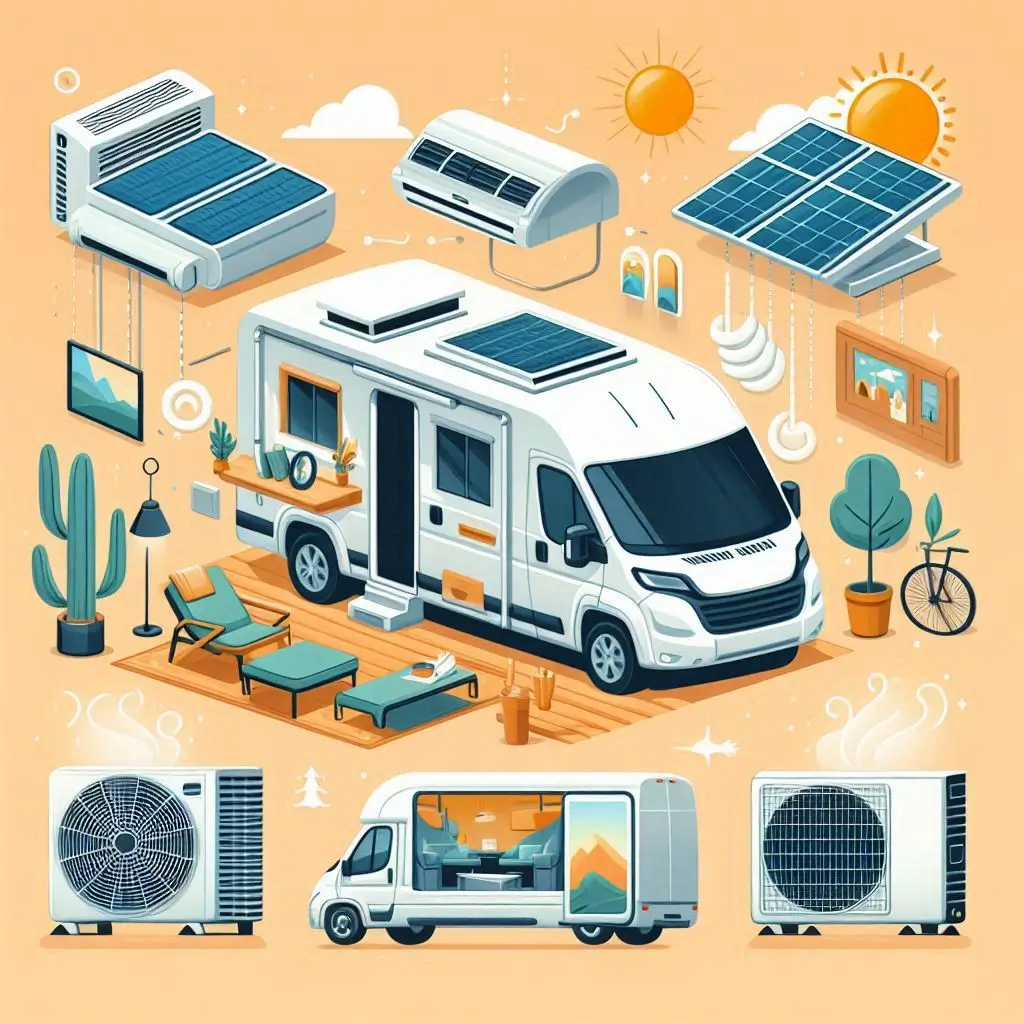
Q2: How do I install an air conditioner in my van?
Installing an air conditioner in your van involves several key steps:
-
Preparation:
- Gather the necessary tools and materials. Ensure your van is suitable for the type of air conditioner you’ve chosen.
-
Location Selection:
- Choose an appropriate location for the AC unit, usually on the roof or in a window, ensuring proper airflow and access to power sources.
-
Installation Process:
- Follow the manufacturer’s installation instructions carefully. For rooftop units, this typically involves securing the unit, sealing any gaps, and connecting it to your van’s electrical system.
-
Testing:
- Once installed, test the air conditioner to ensure it operates correctly and efficiently. Check for any leaks and make adjustments as necessary.
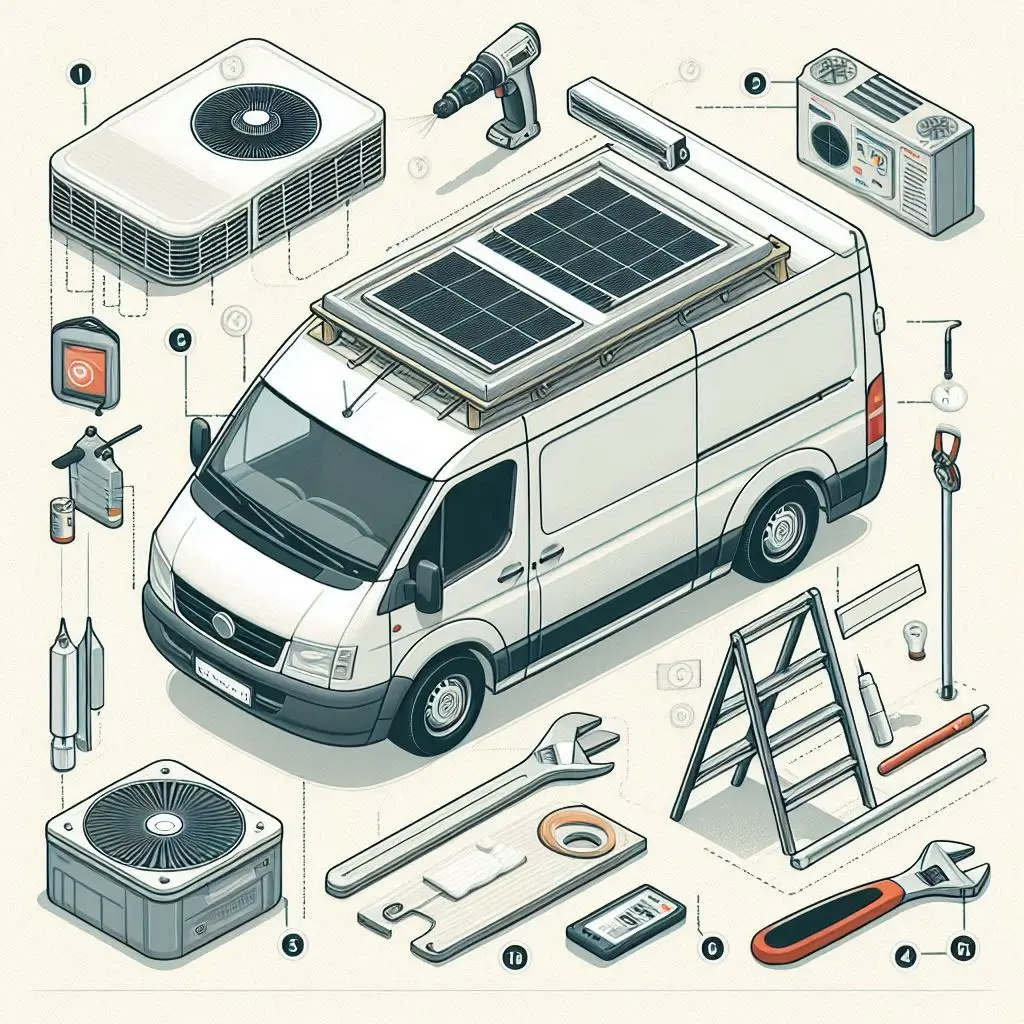
Q3: How can I maintain my van life air conditioner?
Regular maintenance is crucial for the longevity and efficiency of your air conditioner. Here are some maintenance tips:
-
Clean or Replace Filters:
- Inspect and clean or replace air filters monthly to ensure optimal airflow and efficiency.
-
Check Coils and Drain Lines:
- Periodically clean the evaporator and condenser coils and ensure that the drain lines are clear to prevent clogs.
-
Schedule Professional Inspections:
- Consider having a professional technician inspect your AC unit annually to identify potential issues and ensure everything is functioning correctly.

Q4: What are the energy efficiency ratings for van life air conditioners?
Energy efficiency ratings indicate how well an air conditioner uses energy to cool a space. Look for the following ratings:
-
SEER (Seasonal Energy Efficiency Ratio):
- SEER measures the cooling output over a typical cooling season divided by the total electric energy input during the same period. Higher SEER ratings indicate better energy efficiency.
-
EER (Energy Efficiency Ratio):
- EER measures the cooling output at a specific temperature and humidity level. Like SEER, a higher EER rating signifies greater energy efficiency.
-
Energy Star Certification:
- Air conditioners with the Energy Star label meet strict energy efficiency guidelines set by the EPA. Choosing Energy Star-certified units can lead to lower energy bills.
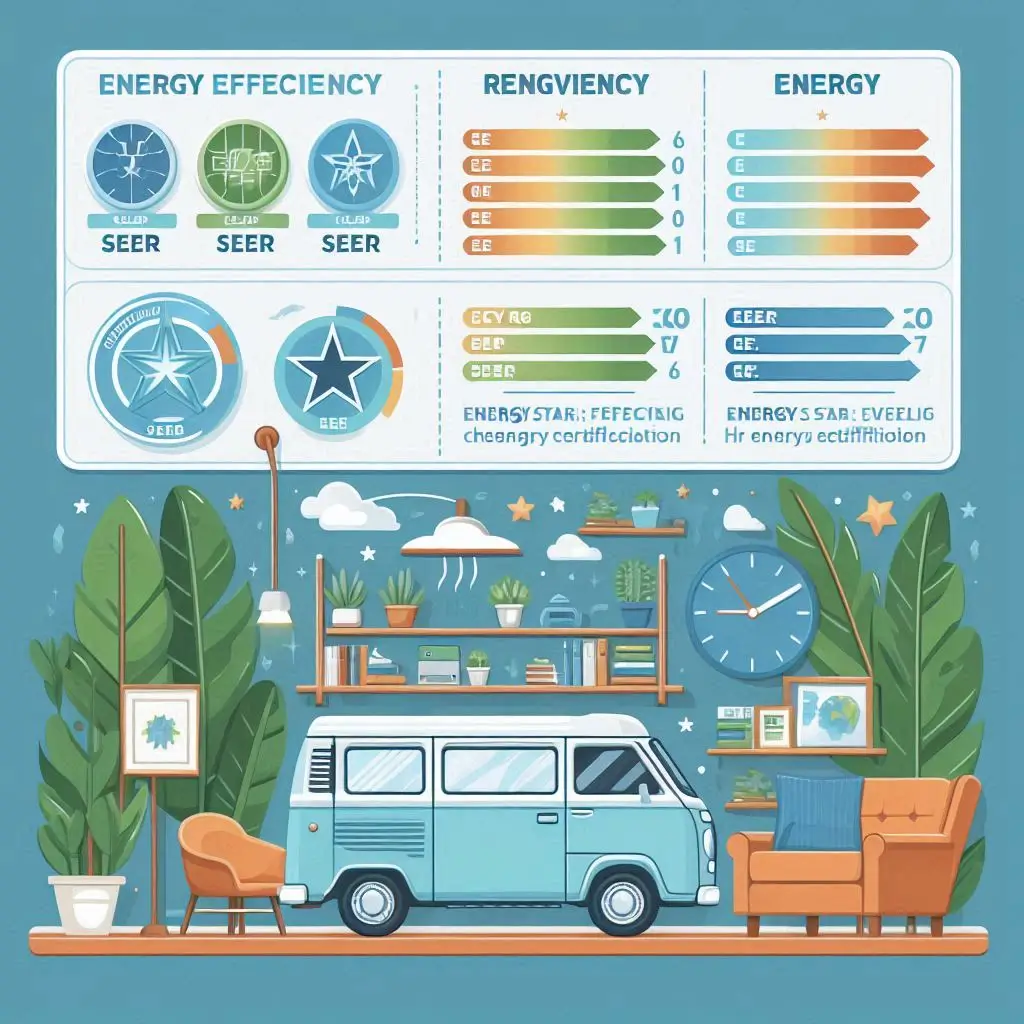
Conclusion
In conclusion, equipping your van with an air conditioner significantly enhances your van life experience by providing essential comfort, improved sleep quality, and better air quality. Whether you choose a rooftop unit, a portable AC, or a ductless mini-split system, understanding the benefits and installation processes is crucial for making the right choice for your mobile lifestyle. With proper maintenance and attention to energy efficiency, your air conditioner can serve as a reliable companion, allowing you to enjoy your adventures in any climate. Embrace the freedom of van life while ensuring a comfortable and refreshing environment, and take the next step toward making your journeys more enjoyable. If you have any further questions or need assistance, feel free to explore more resources or reach out for expert advice!

